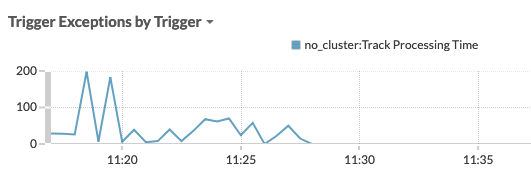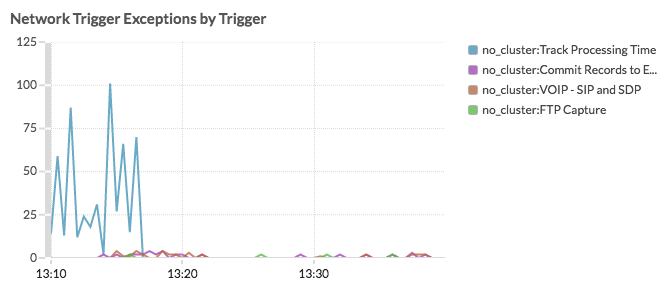Analyze System Health charts to assess trigger performance
Triggers are a powerful tool that can provide detailed insight about your environment. However, triggers consume resources and affect system performance, which is why you must monitor and assess the impact of triggers on your ExtraHop system through system health tools.
In this walkthrough, you will learn how to create a bad trigger, evaluate the negative performance impact with system health tools, and then correct the bad trigger. You will also learn how to create a dashboard to continue monitoring trigger performance.
The tasks in this walkthrough will help you answer the following questions about the impact of triggers on the ExtraHop system:
- Has my new trigger resulted in an exception error?
- How many exceptions errors have occurred?
- What is the performance impact of the my new trigger?
Prerequisites
- You must have access to an ExtraHop system with a user account that has limited write or full write privileges.
- Your ExtraHop system must have SMTP traffic.
- Familiarize yourself with the concepts in this walkthrough by reading the System Health dashboard and Triggers sections in the ExtraHop System User Guide.
- Familiarize yourself with the processes of creating triggers and dashboards by completing the Trigger Walkthrough and the Dashboard Walkthrough.
Create a trigger with exceptions
In this procedure, you will create a simple trigger that logs the processing time of SMTP responses. You will introduce a deliberate error into the trigger configuration to ensure that a trigger exception occurs.
Next steps
Let the trigger run for at least ten minutes, and then check the System Health dashboard.| Tip: | Always check trigger performance charts on the System Health dashboard after you create a new trigger or modify an existing one. By only checking trigger results, such as metrics on a custom dashboard or record queries, you might miss the full picture. For example, a trigger might appear to collect metrics as expected, but might also be consuming a large amount of resources, which could block the trigger queue and lead to triggers getting dropped from the queue. |
Review trigger charts on the System Health dashboard
The System Health dashboard contains charts that pertain to the health and performance of ExtraHop system components and services. In this procedure, you will consult trigger performance charts on the System Health dashboard to check the impact of the trigger you created in the previous section.
| Note: | The performance results reported for the example trigger on your system will differ from the results displayed in this section. |
Fix the trigger and view results on the System Health page
In this procedure, you will view exceptions in the trigger debug log that identify where the problem occurs in the trigger script, and then you will resolve the error.
Create a trigger performance dashboard
In this section, you will create a custom trigger performance dashboard and add several charts discussed in this walkthrough.
Adding system health metrics to a dashboard enables you to customize how you view the data such as choosing the chart type, adding chart notes and tips in text boxes, or adding multiple metrics to a chart.
If you are unfamiliar with creating dashboards, complete the Dashboard Walkthrough. For comprehensive information and procedures for creating and customizing dashboards, see the Dashboards section of the ExtraHop System User Guide.
Next steps
| Tip: | As a next step, you can upload the ExtraHealth Bundle to the ExtraHop system, which installs a dashboard that contains a wide variety of system health charts. Customize the ExtraHealth dashboard to suit your needs, or copy the charts you want to a new dashboard. To learn about bundles, see the Bundles section of the ExtraHop System User Guide. |







Thank you for your feedback. Can we contact you to ask follow up questions?